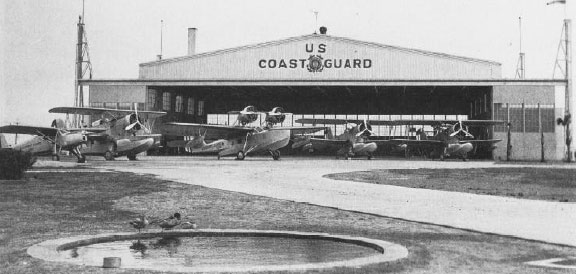
Aircraft left to right — J2K, JF-2, RD-4, JF-2, and JF-2
An aviation training school for pilots and mechanics was established on the banks of the Cooper River on the south end of the Charleston Navy Yard during World War I. It became inactive after the war but remained classified as a Navy Auxiliary Field. In 1934 it was described as having a northwest/southeast sod strip 1680 feet in length and a 1600 foot northeast/southwest sod strip. These were later paved during World War II. Seaplane facilities were also present. The Coast Guard established an air patrol detachment at this location in 1937 with an initial assignment of a Viking OO-1 seaplane.
President Franklin D. Roosevelt issued the first Proclamation of Neutrality on September 5, 1939 declaring in part that any use of United States territorial waters for hostile operations would be regarded as unfriendly, offensive, and in violation of United States neutrality. The Navy initiated action immediately to establish patrol coverage and ordered classified contact reports on foreign men-of-war approaching or leaving the United States East Coast or the eastern boundary of the Caribbean. Ships sighted by the patrols, both air and surface, were to be identified by name, nationality, estimated tonnage, color and markings and were to be photographed whenever possible. On September 6, Commander Atlantic Squadron reported to CNO that the patrol was operating and by the 20th, Atlantic Coastal waters from Nova Scotia Canada to the Lesser Antilles were under daily surveillance. Forces involved were primarily patrol planes from seven patrol squadrons totaling 54 aircraft.
The Navy Neutrality Patrol effort was supplemented by Coast Guard surface and aircraft coverage of coastal areas. The Coast Guard Air Patrol facility at Charleston had been upgraded to Air Station status in 1939. VP-52 and VP-53, both based in Norfolk, patrolled the mid-Atlantic coastal shipping lanes. Experience during the first month of operation dictated changes in the deployment of forces to improve coverage in the assigned areas. VP-52 was moved to the Coast Guard Air Station at Charleston as a tenant. The Air Station supplied the seaplane ramp, aircraft parking area and aircraft maintenance facilities. Renovations and modifications to existing facilities were made.
VP-52 was composed of 12 P2Y aircraft. Coast Guard Air Station Charleston had six aircraft; three JF-2s, a Coast Guard RD-4 and two J2Ks. VP-52 provided co-pilots for the RD and the J2Ks. The scope of Neutrality Patrol operations gradually expanded. New Squadrons were added and obsolescent aircraft were replaced. VP 52 exchanged its P2Ys for PBY-5s in December of 1940. VP 52 moved from Charleston at that time because the facilities could not support PBY operations.
In January of 1941 the Coast Guard traded four JF-2s to the Navy for four N3N training aircraft. These aircraft were needed to accelerate Coast Guard pilot training in order to address the acute shortage of pilots. The aircraft were assigned to the Charleston Air Station where initial training, prior to assignment to Pensacola, took place. The former air station duties were assumed by Coast Guard Air Station Elizabeth City which had been commissioned in August of 1940. During 1941 there were 11 Commissioned Officers and 11 Aviation Pilots that were designated Naval Aviators. Upon completion of initial flight training operations during the summer of 1941, Coast Guard Air Station Charleston was decommissioned. Two N3Ns were assigned to Air Station St. Petersburg, one to Air Station Brooklyn, and one to Air Station Elizabeth City.

Coast Guard N3N V-196 — Designed by the U.S. Navy Bureau of Aeronautics, it was built by the Naval Aircraft Factory (NAF). The NAF was established by the U.S. Navy in 1918 at Philadelphia to provide the Navy with its own manufacturing and test organization. The NAF also built aircraft designed by other manufacturers to evaluate the cost of aircraft submitted by industry. The NAF ended production in 1945. The prototype XN3N-1 first flew in August 1935. It had a wing span of 34 feet and was 25 feet 7 inches long. Powered by a Wright whirlwind 225R-760-2 the aircraft had a sea-level climb of 860 feet per minute and a cruise speed of 76 mph. It was well suited as a primary trainer.
Small PBY and PBM detachments continued to operate from the former air station facilities and Lighter Than Air Squadron ZP-15 maintained a continuous detachment of 2 blimps that flew daily ASW patrols. All aviation activity was discontinued at the end of World War II.

